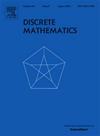非对称嵌套正交数组的界
IF 0.7
3区 数学
Q2 MATHEMATICS
引用次数: 0
摘要
嵌套正交阵列在各种实验中得到越来越广泛的应用。noa研究中的一个重要问题是确定最小运行次数,即找到noa的行边界。这些界限在证明不存在性方面是相当有力的。尽管对称noa的边界已经推导了十多年,但非对称noa的边界仍然是一个开放的问题。本文介绍了非对称noa的边界。本文章由计算机程序翻译,如有差异,请以英文原文为准。
Bounds for asymmetric nested orthogonal arrays
Nested orthogonal arrays (NOAs) are more and more widely used in diverse experiments. An important problem in the study of NOAs is to determine the minimal number of runs, i.e., to find the bounds on the rows for NOAs. These bounds are quite powerful in proving nonexistence. Although the bounds for symmetric NOAs were derived over a decade, the bounds for asymmetric NOAs remain an open problem. This article presents the bounds for asymmetric NOAs.
求助全文
通过发布文献求助,成功后即可免费获取论文全文。
去求助
来源期刊

Discrete Mathematics
数学-数学
CiteScore
1.50
自引率
12.50%
发文量
424
审稿时长
6 months
期刊介绍:
Discrete Mathematics provides a common forum for significant research in many areas of discrete mathematics and combinatorics. Among the fields covered by Discrete Mathematics are graph and hypergraph theory, enumeration, coding theory, block designs, the combinatorics of partially ordered sets, extremal set theory, matroid theory, algebraic combinatorics, discrete geometry, matrices, and discrete probability theory.
Items in the journal include research articles (Contributions or Notes, depending on length) and survey/expository articles (Perspectives). Efforts are made to process the submission of Notes (short articles) quickly. The Perspectives section features expository articles accessible to a broad audience that cast new light or present unifying points of view on well-known or insufficiently-known topics.
 求助内容:
求助内容: 应助结果提醒方式:
应助结果提醒方式:


